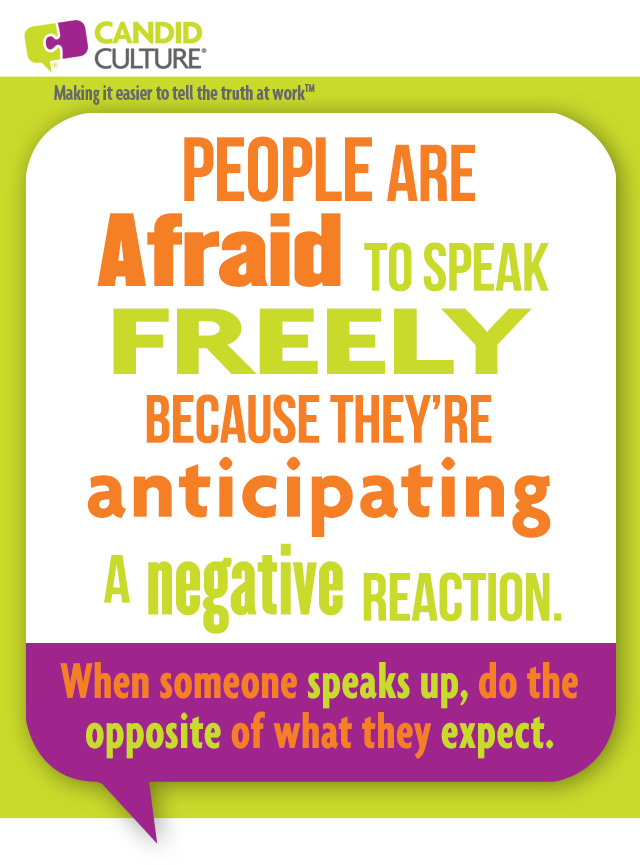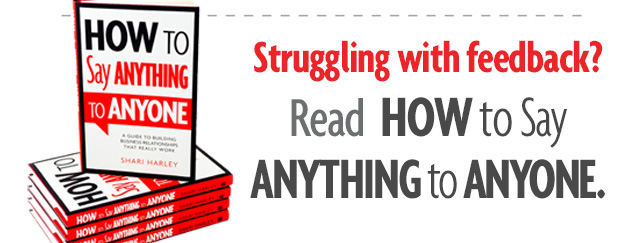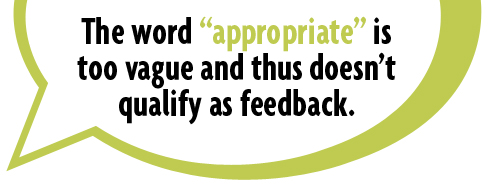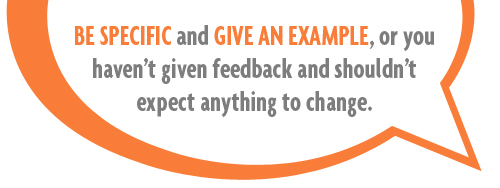Posts Tagged ‘feedback conversations’
Last week one of my friends was concerned about something happening at her son’s school. She wrote out what she planned to say to the school principal and sent it to me to read. Her letter was long, with lots of unnecessary details. I read five paragraphs before understanding what the situation was even about. I revised her letter. My version was three sentences and easy to write. Why? Because it’s not my child and not my situation.
One of the things that makes giving feedback and making requests particularly difficult, is our emotional involvement. We’re invested in the outcome. The stakes feel high. And that emotion makes everything harder.

If you’re struggling with a message you need to deliver, get some help. The person who helps you craft a succinct, specific, and unemotional message doesn’t have to be a feedback expert or a manager. The person just can’t be involved. As long as the person isn’t emotionally involved, they’ll be helpful.
When you ask for help, don’t ask for advice. Instead of asking a friend or colleague, “What would you do in this situation,” ask, “What would you say?” These are very different questions. You want the specific words to resolve whatever you’re struggling with.
Asking someone for help planning a challenging conversation or message begs the question, isn’t asking for that type of help a form of gossip? It could be. So be careful who you ask.
When asking for help planning a message or conversation, ask someone in your organization who is at your same level or above (title-wise) or ask someone outside of the organization. Change the names of the people involved; protect people’s anonymity. And be clear if you are asking for help to plan a conversation or if you are venting. They are not the same.
The most effective feedback and requests are unemotional, factual, and succinct. Sometimes we need other people who are not involved to help us get there.

Last week one of my friends was concerned about something happening at her son’s school. She wrote out what she planned to say and sent it to me to read. Her notes were long, with lots of unnecessary details. I read five paragraphs before understanding what the situation was even about. I revised the notes. My notes were three sentences and easy to write. Why? Because it’s not my child, not my situation.
What makes giving feedback and making requests particularly difficult is our emotional involvement. We’re connected to the outcome. The stakes feel high. And that emotion makes everything harder.

If you’re struggling with a message you need to deliver, get some help. The person who helps you craft a succinct, specific, and unemotional message doesn’t have to be a feedback expert or a manager. The person just can’t be involved. As long as the person isn’t emotionally involved, they’ll be helpful.
When you ask for help, don’t ask for advice. Instead of asking a friend or colleague, “What would you do in this situation,” ask, “What would you say?” These are very different questions. You want the specific words to resolve whatever you’re struggling with.
Asking someone for help planning a challenging conversation or message begs the question, isn’t asking for that type of help a form of gossip? It could be. So be careful who you ask.
When asking for help planning a message or conversation, ask someone in your organization who is at your same level or above (title-wise) or ask someone outside of the organization. Change the names of the people involved; protect people’s anonymity. And be clear if you are asking for help to plan a conversation or if you are venting. They are not the same.
The most effective feedback and requests are unemotional, factual, and succinct. Sometimes we need other people who are not involved to help us get there.
If you’ve gotten courageous and given someone negative feedback or questioned a decision or action, you probably didn’t get a shiny, happy reply in return. The normal and natural reaction to negative feedback or data is to defend ourselves. It’s human. Defending yourself when receiving negative feedback is an act of self-preservation, not unlike hitting your brakes when the person driving in front of you unexpectedly slams on their brakes.
The problem with reacting defensively (normally) to negative feedback is that it’s scary and off-putting to others. As normal as a defensive reaction is to negative feedback, it makes others so uncomfortable that they’ll be hesitant to give you negative feedback again. And this lack of knowledge of what others really think is dangerous. Silence inhibits career growth and leads to bad business decisions. You want people to tell you the truth, as they see it. So you need to make it easy to speak freely.
If you want more of what others see as the truth, do the opposite of what people expect. Rather than defending or going silent, say “thank you.” “Thank you for telling me that. I’ll think about what you said and will likely come back to you to discuss further,” buys you time and puts the other person at ease.
Here are five ways to make it easier to say thank you for the feedback:
- Only accept feedback when you’re ready to listen. You’re allowed to put people on ice and come back to them when you have time to talk. Bad days, when you have five minutes between meetings, or are about to leave for a vacation are not the times to accept negative information. Set up a time to talk, as soon as you have the bandwidth to listen.
- Take breaks during hard conversations. You’re allowed to say, “I need a few minutes.” Go get coffee. Take a walk. Go outside. Regain your composure. Then continue the conversation.
- Have feedback conversations when you’re rested and have eaten. Everything seems bigger and more difficult when we’re tired or hungry.
- Accept that “thank you” isn’t the same as telling the other person she is right or that you agree. “Thank you” is a mere acknowledgment that you heard. It buys you time and gives you a chance to gather your thoughts and respond when you’re not emotional.
- Don’t have conversations when you’re upset, and we often don’t know when we’re upset. Your emotions will run the show. Give yourself time to get through your emotional response, and then talk.
People are more hesitant than you think to tell you when they disagree. Make it easy to speak up. Do the opposite of what others expect. Say “thank you” rather than reacting, and you’ll get more data than you do now.
If you’ve gotten courageous and given someone negative feedback or questioned a decision or action, you probably didn’t get a shiny, happy reply in return. The normal and natural reaction to negative feedback or data is to defend ourselves. It’s human. Defending yourself when receiving negative feedback is an act of self-preservation, not unlike hitting your brakes when the person driving in front of you unexpectedly slams on their brakes.

The problem with reacting defensively (normally) to negative feedback is that it’s scary and off putting to others. As normal as a defensive reaction is to negative feedback, it makes others so uncomfortable that they’ll be hesitant to give you negative feedback again. And this lack of knowledge of what others really think is dangerous. Silence inhibits career growth and leads to bad business decisions. You want people to tell you the truth, as they see it. So you need to make it easy to speak freely.
If you want more of what others see as the truth, do the opposite of what people expect. Rather than defending or going silent, say “thank you.” “Thank you for telling me that. I’ll think about what you said and will likely come back to you to discuss further,” buys you time and puts the other person at ease.
Here are five ways to make it easier to say thank you for the feedback:
- Only accept feedback when you’re ready to listen. You’re allowed to put people on ice and come back to them when you have time to talk. Bad days, when you have five minutes between meetings, or are about to leave for a vacation are not the times to accept negative information. Set up a time to talk, as soon as you have the bandwidth to listen.
- Take breaks during hard conversations. You’re allowed to say, “I need a few minutes.” Go get coffee. Take a walk. Go outside. Regain your composure. Then continue the conversation.
- Have feedback conversations when you’re rested and have eaten. Everything seems bigger and more difficult when we’re tired or hungry.
- Accept that “thank you” isn’t the same as telling the other person she is right or that you agree. “Thank you” is a mere acknowledgment that you heard. It buys you time and gives you a chance to gather your thoughts and respond when you’re not emotional.
- Don’t have conversations when you’re upset, and we often don’t know when we’re upset. Your emotions will run the show. Give yourself time to get through your emotional response, and then talk.
People are more hesitant than you think to tell you when they disagree. Make it easy to speak up. Do the opposite of what others expect. Say “thank you” rather than reacting, and you’ll get more data than you do now.

Last week I was upset, really upset. I worked hard to practice what I preach when giving feedback – wait to talk until I’m calm, ask questions, and no matter what happens, don’t send a text message. It was hard, really hard.
I was mad and wanted to say, “What the *&^#$@?” But I know that when people receive negative feedback they feel judged. And when people feel judged, they become defensive, making it very difficult to hear what the other person is saying and have a conversation.
When my emotions don’t get the best of me, I plan hard conversations by asking myself these questions:
- What do I want to have happen as a result of the conversation?
- How do I need to approach the conversation to get that result?
Knowing that if I want to have a good conversation, I need to reduce the other person’s defensiveness, I often start feedback conversations by asking the neutral question, “Help me understand; what happened the other day?”
Last week one of my employees tipped me off that the people who work for me are on to me. They’ve read my book. When I ask, “Help me understand; what happened the other day,” they know that feedback will follow.
You don’t want to approach your relationships and conversations in a formulaic and inauthentic way. Inauthenticity stinks and it can damage relationships more than freaking out will do. But it’s not a terrible thing to put someone on notice. If the people who work with me know that negative feedback follows the question “what happened,” they know the conversation is important. Yes, they’ve been tipped off and perhaps as a result they’re on the defensive, but I still think asking “what happened yesterday” is a heck of a lot better than raising your voice, accusing, and asking questions later.
Asking questions to discuss thwarted expectations is hard to practice. It takes great self-management, which I don’t always have. I mostly practice what I teach, and when I don’t, I clean up the mess I’ve made, apologize and recommit to doing so in the future. And you can do the same.
A Few Practices to Consider:

Holiday Promo – $12 a book for 7 or more books.
- Wait to give feedback until you won’t freak out, but don’t let situations fester and become bigger than they need to be. Have the conversation as soon after an event as possible.
- If something is important to you, ask for it. Trying to persuade yourself that it isn’t a big deal and might be your issue, probably won’t help. We want what we want. Be true to yourself.
- Consider starting hard conversations with “help me understand.”
And when you find that you’ve put the other person on the defensive and s/he feels judged, work to do better next time. But in the end, speaking up is always better than stuffing how you feel, even if you handle the conversations differently than you had planned.
No one wants to tell you you’re dressed inappropriately for work.
The office dress code conversation seems to be feedback managers avoid and struggle with the most. Perhaps because attire is so personal, I’m not sure. But I do know that I’m getting more and more requests to train managers how to give employees feedback that their butt crack is showing. Yes, really.
Many employees push the envelope on the office dress code during the summer, breaking out tank tops, jeans and capri’s. The problem with dressing this casually is that some of the people you work with will judge you for it, but they are not likely to tell you. They’ll just decide you have poor judgment and that you may not be the right person to stand in for your boss at a meeting or conference.
A couple of office dress code guidelines to follow, unless you work in a very casual office environment where even the folks at the top wear jeans and t-shirts to work:
- Make friends with your iron, or a dry cleaner.
- If you put something on and ask “Can I get away with this,” the answer is most likely no.
- Ladies, your cleavage should never show at work. Never ever. It will only limit your career.
- T-shirts and cargo pants are not business casual.
- Capris and sandals are ok, if your company allows them. Spandex and shorts are not.
- Thongs and butt cracks are a no-no. Ladies, don’t wear low rides to work. Men, if your belt sits below your stomach, buy a bigger pair of pants and raise the belt. This will solve the butt crack problem.
- Ladies check your skirt length. If it’s too tight or too short, it’s not for the office.
- Lots of women are wearing really high heels to work. They look great, at a club.
- General rule of thumb, if can comfortably leave work and go to a club or a baseball game, you’re not dressed conservatively enough for work.
Most of these suggestions are aimed at women because women have more flexibility with clothing and thus a greater margin for error. Men have the man’s business casual uniform: khakis and a button down or golf shirt. That’s hard to screw up, unless of course you sleep in the khakis.
Here’s how you can give a woman feedback that she isn’t dressed appropriately for your office dress code:
“I’ve noticed that some of your clothing shows cleavage. When people look at you, I want them thinking about how smart you are and all that you add to our organization. I don’t want them distracted with something else.” Replace cleavage with whatever misstep the person is making.
Here’s another example: “I’ve noticed that you wear short skirts and pretty high shoes to work. We work in a pretty conservative environment. You always look great, but not for our office environment. I’m going to ask you to wear longer skirts, that aren’t as form fitting, with lower shoes. I know this conversation is awkward, and I appreciate that you’re willing to have it with me. When people look at you I want them thinking about how smart you are and all that you add to our organization. I don’t want them distracted with something else.”

Notice, I didn’t say, “You’re not dressed appropriately for work.” The word “appropriate” is too vague and thus doesn’t qualify as feedback. Being vague doesn’t tell the person what to do differently. If your employees felt that what they are wearing to work was inappropriate, they’d wear something else. You need to spell it out. And this is true for all forms of feedback. Be specific and give an example, or you haven’t given feedback and shouldn’t expect anything to change.

Men, you can’t have this conversation with the women in your office. Ask a woman the employee has a relationship with to have the conversation on your behalf.
Read How to Say Anything to Anyone to get the words to have other difficult feedback conversations.
Some of you are currently gasping, thinking there is no way you can have this conversation. Yes you can. I have these office dress code conversations with clients regularly without damaging my relationships. So few people will tell someone when they’re wearing clothing that damages their reputation, when the feedback recipient gets over being shocked and embarrassed, s/he’ll thank you for caring enough to give such honest feedback.









